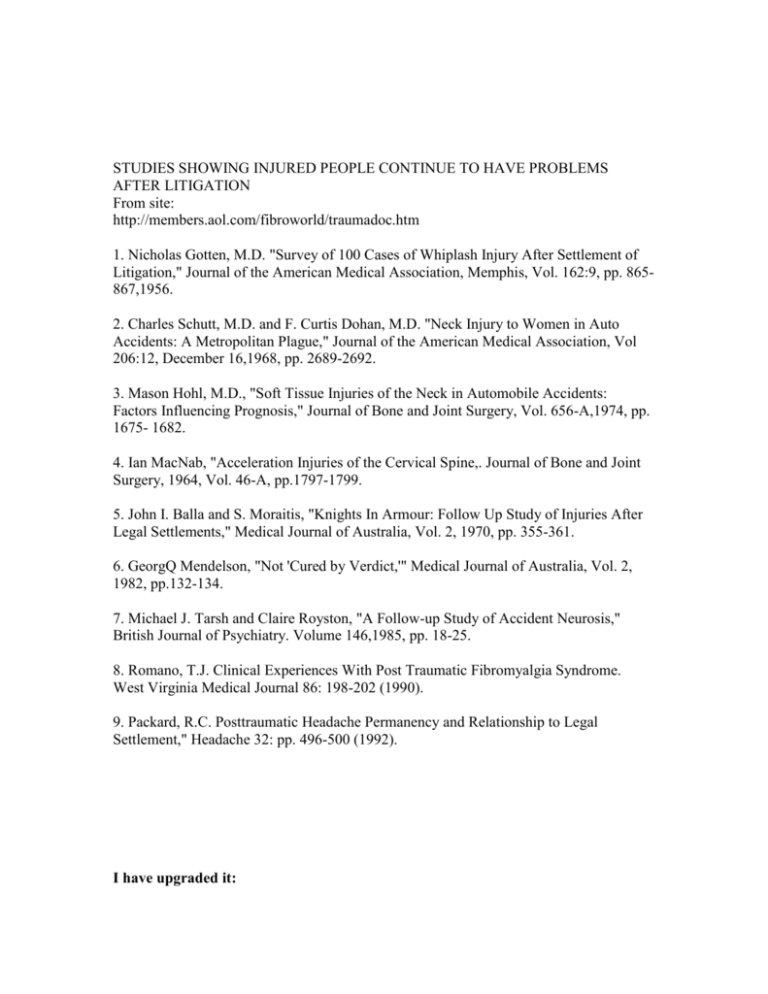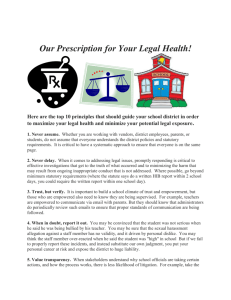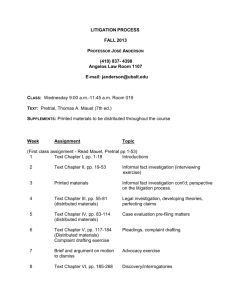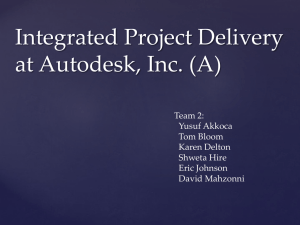
STUDIES SHOWING INJURED PEOPLE CONTINUE TO HAVE PROBLEMS
AFTER LITIGATION
From site:
http://members.aol.com/fibroworld/traumadoc.htm
1. Nicholas Gotten, M.D. "Survey of 100 Cases of Whiplash Injury After Settlement of
Litigation," Journal of the American Medical Association, Memphis, Vol. 162:9, pp. 865867,1956.
2. Charles Schutt, M.D. and F. Curtis Dohan, M.D. "Neck Injury to Women in Auto
Accidents: A Metropolitan Plague," Journal of the American Medical Association, Vol
206:12, December 16,1968, pp. 2689-2692.
3. Mason Hohl, M.D., "Soft Tissue Injuries of the Neck in Automobile Accidents:
Factors Influencing Prognosis," Journal of Bone and Joint Surgery, Vol. 656-A,1974, pp.
1675- 1682.
4. Ian MacNab, "Acceleration Injuries of the Cervical Spine,. Journal of Bone and Joint
Surgery, 1964, Vol. 46-A, pp.1797-1799.
5. John I. Balla and S. Moraitis, "Knights In Armour: Follow Up Study of Injuries After
Legal Settlements," Medical Journal of Australia, Vol. 2, 1970, pp. 355-361.
6. GeorgQ Mendelson, "Not 'Cured by Verdict,'" Medical Journal of Australia, Vol. 2,
1982, pp.132-134.
7. Michael J. Tarsh and Claire Royston, "A Follow-up Study of Accident Neurosis,"
British Journal of Psychiatry. Volume 146,1985, pp. 18-25.
8. Romano, T.J. Clinical Experiences With Post Traumatic Fibromyalgia Syndrome.
West Virginia Medical Journal 86: 198-202 (1990).
9. Packard, R.C. Posttraumatic Headache Permanency and Relationship to Legal
Settlement," Headache 32: pp. 496-500 (1992).
I have upgraded it:
Post-traumatic headaches Evans RW;
NEUROLOGIC CLINICS 22 (1): 237-+ FEB 2004
Post-traumatic headaches are one of the most common and controversial secondary
headache types. After mild head injury, up to 50% of people develop a post concussion
syndrome, which has been controversial for over 135 years. Headache is estimated as
present in 30% to 90% of patients after mild head injury. Most headaches are of the
tension type, although migraines can increase in frequency or occur acutely or
chronically de novo. The treatments are the same as for the primary headaches.
Approximately 20% of patients have persistent post-traumatic headaches for more than 1
year, which may not resolve despite the settlement of any pending litigation.
-------------------------------------------------------------------------------11. Chronic post-traumatic headache after mild head injuries
De Souza JA, Moreira PF, Jevoux CD
ARQUIVOS DE NEURO-PSIQUIATRIA
57 (2A): 243-248 JUN 1999
Abstract:
Current evidence indicates that chronic post-traumatic headache (cPTH) has organic
causes. Nevertheless, these patients are considered as neurotics or malingering by health
professionals, mainly if the headache originates from mild head injuries (MHI). Our aim
was to identify the features of cPTH after MHI. We studied 27 consecutive patients
fulfilling the criteria established for cPTH and MHI. Headache began on the same day of
the trauma in 51.8% of patients. The clinical features allowed the following diagnosis:
migraine (70.3%); tension type headache (51.8%); cervicogenic headache (11.1%).
Concomitance of migraine and tension type headache was found in 29.6%. Thirty three
percent of employees, 40% of housewives and 50% of students in our series referred
prejudice in their productive activities. However, only three patients (11.1%) were
claiming for compensation. The lack of potential gain and the uniformity of the clinical
presentation are suggestive that the cPTH has an organic cause.
Minor head injury
Swenson RS
JNMS-JOURNAL OF THE NEUROMUSCULOSKELETAL SYSTEM
5 (4): 133-143 WIN 1997
Abstract:
THE SEQUELLAE OF MINOR HEAD INJURY are quite common and may develop
even in the absence of loss of consciousness, In fact, there is no significant difference in
frequency of reported symptoms in patients who are only stunned or dazed when
compared with patients having suffered a brief period of unconsciousness. The symptoms
which may follow head injury include physical symptoms such as headache and
"dizziness," psychological symptoms such as irritability and personality change, and
cognitive symptoms including problems with concentration, speed of information
processing, divided attention tasks, and "memory." While occasionally these symptoms
may be ascribed to specific injury to certain tissues of the head, experimental studies
reflect that the majority of time the injury is to fine processes of the nervous system and
to neurotransmitter systems. This means that conventional imaging such as CT and MRI
scanning is usually normal and mostly has a place in ruling out more serious injuries to
brain parenchyma. The prognosis for symptoms of minor head injury is generally for
slow recovery. This recovery may require months and is incomplete in around 20% of
individuals. Patients with symptoms lasting more than a year have a relatively poor
prognosis for complete resolution of symptoms. Since many of these cases are involved
with medicolegal issues, some clinicians have argued for a substantial effect of
"compensation neurosis." However, studies have not shown significant differences in
the clinical picture for patients undergoing litigation when compared to groups of
patients without pending litigation. Additionally, there have been no studies
showing that patients are "cured by verdict," which would be anticipated if
litigation was a strong driving force for continued symptoms. This review article also
discusses various issues of evaluation and management of these patients.
Temporomandibular disorders, headaches, and neck pain after motor vehicle accidents: A
pilot investigation of persistence and litigation effects
Kolbinson DA, Epstein JB, Burgess JA, Senthilselvan A
JOURNAL OF PROSTHETIC DENTISTRY
77 (1): 46-53 JAN 1997
Abstract:
Statement of problem. There is a lack of long-term follow-up studies that involve postmotor vehicle accident temporomandibular disorders and compensation.
Purpose of study. The purposes of this retrospective pilot study were (1) to assess patients
who had previously been treated for temporomandibular disorders after motor vehicle
accidents to determine the nature of their symptoms in terms of jaw, head, and neck pain
and jaw dysfunction and (2) to determine whether there was a difference in the pain and
dysfunction between those who had settled and those who had not settled their insurance
claims.
Material and methods. Thirty previously treated patients with temporomandibular
disorders after motor vehicle accidents were questioned by telephone regarding litigation
status and current jaw head, and neck pain and jaw dysfunction symptoms. They did not
differ substantially from a smaller group who were not able to be interviewed.
Descriptive statistics were calculated and statistical tests were performed. A total of 22
patients had their claims settled.
Results. Approximately three fourths had persistent complaints of jaw pain, jaw
dysfunction, and headache, and more than 80% reported persistent neck pain. No
apparent differences were found between these who had and had not settled their
insurance claims.
Conclusion. Jaw, head and neck pain, and jaw dysfunction continued to be problems
for the majority of this patient population, regardless of litigation status in this
retrospective study.
----------------------COMPENSATION NEUROSIS REVISITED - OUTCOME STUDIES OF THE
EFFECTS OF LITIGATION
MENDELSON G
JOURNAL OF PSYCHOSOMATIC RESEARCH
39 (6): 695-706 AUG 1995
Abstract:
Although the term 'compensation neurosis' has been frequently used to describe personal
injury litigants, its clinical validity-and the assumptions about individuals described by
this label-have not been critically examined. This article reviews the concept of
'compensation neurosis' and follow-up studies of claimants for compensation following
the finalisation of their legal proceedings. A follow-up study of 760 litigants found that,
of the 264 subjects who were not working at the time of conclusion of litigation and who
could be traced, 198 (75%) were not working after an average of 23 months following
the finalization of their cases.
COMPENSATION AND PSYCHIC TRAUMA - A STUDY OF ISRAELI COMBAT
VETERANS
SOLOMON Z, BENBENISHTY R, WAYSMAN M, BLEICH A
AMERICAN JOURNAL OF ORTHOPSYCHIATRY
64 (1): 91-102 JAN 1994
Abstract:
The precursors and outcomes of compensation-seeking in Israeli war psychiatric
casualties were examined. Findings suggest that compensation was sought by veterans
who had experienced the most severe traumas and had subsequently developed the most
severe symptoms and functional limitations. Reported range and severity of symptoms
and functional limitations did not diminish with compensation.
WORKERS COMPENSATION AND RETURN-TO-WORK IN LOW-BACK-PAIN
GALLAGHER RM, WILLIAMS RA, SKELLY J, HAUGH LD, RAUH V, MILHOUS
R, FRYMOYER J
PAIN
61 (2): 299-307 MAY 1995
Abstract:
The relationship of Workers' Compensation and litigation to low back pain (LBP)
outcome is not established in the literature. Our study investigated the characteristics of
disabled persons applying for Worker's Compensation or employing a lawyer, the factors
predicting receipt of compensation, and the effects of compensation and litigation on
employment outcome. One hundred sixty-nine unemployed persons with LBP were
assessed by medical history, physical exam, biomechanical testing, psychiatric interview,
and MMPI. Subjects were asked whether they had applied for compensation, received it,
or had employed a lawyer. Six months later, subjects were asked about their employment
and compensation status. Neither compensation status nor involvement of a lawyer
significantly improved prediction of employment status 6 months later. Receipt of
compensation predicted better outcome in those at risk for poor outcome due to external
locus of control. Factors predicting failure to obtain compensation over 6 months, having
applied, include education, spinal flexion, ability to do daily activities and affective
inhibition. Neurological dysfunction did not predict receipt of compensation in univariate
or multivariate analyses; emotional distress reduced the probability of receiving
compensation, after controlling for severity of spinal dysfunction. Receipt of
compensation and use of a lawyer did not reduce the probability of RTW in
disabled persons in the present Sample, but increased the likelihood of return to work
for groups of individuals at higher risk such as those with external locus of control.
Although compensation is awarded on the basis of physical evaluation under the present
system, the present findings suggest that the likelihood of receiving compensation is also
significantly determined by level of emotional distress.
Prediction of prolonged work disability in occupational low-back pain based on nurse
case management data
Okurowski L, Pransky G, Webster B, Shaw WS, Verma S
JOURNAL OF OCCUPATIONAL AND ENVIRONMENTAL MEDICINE
45 (7): 763-770 JUL 2003
Abstract:
This study evaluated whether risk prediction data captured by nurse case managers
(NCMs) could predict prolonged disability from occupational low back pain. Cases of
uncomplicated occupational low back pain referred to NCMs,with dates of injury
between January 1, 1997 and June 30, 1998, were selected (n = 986). Predictive
information was obtained from the NCM screening checklist of potential risk factors and
other administrative claims data. Data were collected on 23 variables thought to predict
work status at 6 months postinjury. In a multivariate logistic regression model, being out
of work was significantly associated with older age, language barriers, earlier referral to
NCM, and neutral or negative attorney attitude toward return to work. The overall
predictive power of the model was low (area under curve = 0.6). Although NCM risk
factor data collection is feasible and practical in insurance settings, future studies should
explore additional variables and refined data collection methods in order to achieve a
more accurate prediction.
Probably best article:
Employment and litigation: improved by work, assisted by verdict
Suter PB
PAIN
100 (3): 249-257 DEC 2002
Abstract:
Previous research exploring the relationship between litigation status and the symptoms
of the plaintiff has been inconsistent and limited by methodological difficulties. This
longitudinal study addressed many of the methodological shortcomings of previous
research and examined the relationship between litigation status, employment.
depression, pain and disability over the duration of the compensation process. Two
hundred chronic back pain participants were selected from patients who attended an
initial assessment interview at a pain centre. According to their litigation and
employment Status these patients were divided into four groups, namely a non-litigating
non-working group, a non-litigating working group. a litigating non-working group and a
litigating working group. All participants completed three questionnaires. one at intake.
one at a minimum of 2 bears later (for litigants during the litigation process). with the
final questionnaire completed at a minimum of 15 months thereafter (for litigants after
they had settled their claim). Questionnaires contained measures of pain (Visual
Analogue Scale. Short Form McGill Pain Questionnaire), depression (Zung Self-Rating
Depression Scale), and disability (Oswestry Disability Questionnaire),
Overall participants who were working scored lower on all the Measures than did
participants who were not working. On the other hand participants who were litigating
scored higher on all the measures than did participants who were not litigating. There was
a significant time effect on all measures but this was, qualified on some measures by the
interactions of time with litigation status and work status. The present research further
demonstrated that both litigation and employment were significant factors influencing
recovery from injure (C) 2002 International Association for the Study of Pain. Published
by Elsevier Science B.V. All rights reserved.
They basically found that litigating subjects were in more pain than their nonlitigating counterparts until after settlement when it became similar to that of nonlitigating injured. It appeared from their analysis that litigating subjects could be
more badly injured and that anger and stress of litigation kept them higher until
after litigation was finished (though litigation effect couldn’t be ruled out). Needless
to say the “green poultice” settlement didn’t cure them as their problems continued
long after settlement:
Table from article showing similar outcomes though initial higher ratings:
THE ROLE OF LITIGATION IN PREDICTING DISABILITY OUTCOMES IN
CHRONIC PAIN PATIENTS
SOLOMON P, TUNKS E
CLINICAL JOURNAL OF PAIN
7 (4): 300-304 1991
Abstract:
This study examined the extent to which being involved in civil and industrial litigation
predicted outcome in an population of chronic pain patients. Data were collected in a
structured telephone interview for a litigant group of 80 patients and a nonlitigant group
of 47 patients. There were no significant differences in the amount of medication used,
the number of hours spent resting per day, or the number of individuals who were able to
return to work. Litigants showed significantly higher levels of depression. Multiple
regression analyses indicated that litigation was not the primary predictor of downtime or
medication use. Litigation was found to be the primary predictor of Zung depression
scores. Discriminant function analyses indicated that litigation was not the most
important variable in distinguishing between those working and not working. Results
lend support to previous studies that suggest that the suspicion and disbelief with
which litigating patients are often treated is unfounded.






